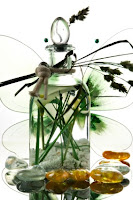.jpg)
More and more people are becoming allergic or extremely sensitive to the chemicals found in brand name perfumes and skin care products. Before discovering aromatherapy and beginning to work with essential oils, I commonly used synthetic perfumes and brand name skin care products because I didn't understand what the actual ingredients of these perfumes were.
Now, I can't be in the vicinity of a synthetic perfume without having an adverse reaction to it! And I have slowly changed my skin care routine to include only products I have made with pure essential oils.
Although essential oils, as we know them today, weren't around hundreds of years ago, a form of 'aromatherapy' was; people used natural plants and oils from plants for cosmetic purposes.
Since historic times, many ancient civilizations have used natural plants and oils in their skin care routines. The Romans were famous for adding lavender to the Roman baths; the Romans also thought highly of rose too. On a trip to the ancient city of Pompeii in Italy last summer, I was fascinated to discover that excavations of Pompeii have unearthed proof that many Pompeiians both grew and used many flowers and herbs for culinary and cosmetic purposes; these plants are ones which we are familiar with today and include rose, lily, laurel, fennel, myrtle and myrrh.
Another important figure from history - this time French history - is Marie Antoinette of France (1755 - 1793) who used many natural perfumes and oils in her skin care routine; Marie Antoinette had her own personal perfumer to make her natural scents and lotions on a whim. In fact, it is said that Marie Antoinette's obsession with her perfumes and lotions may have cost her her life; the delay in preparations for fleeing France was due to Marie Antoinette's toilette preparations, which made those no longer loyal to the Queen suspicious of her intentions. Marie Antoinette was eventually captured and sent to the guillotine.
For more information, read my articles The Perfumes of Marie Antoinette and The Ancient Perfumes of Pompeii.
If you are really interested in Marie Antoinette of France and, in particular her use of perfumes, I highly recommend reading A Scented Palace by Elisabeth de Feydeau 2007 I.B. Tauris and Co. Ltd (UK and USA).
For more on the ancient perfumes of Pompeii I highly recommend Perfumes, Unguents and Hairstyles in Pompeii (Profumi, ungenti e acconciature in pompei antica) by Carlo Giordano, Angelandrea Casale 2nd edition Bardi Editore Roma, Italia.
If you have any thoughts or comments on the historical use of aromatherapy in skin care please post a comment!
Next time, I'll discuss essential oils suitable for skincare...
Now, I can't be in the vicinity of a synthetic perfume without having an adverse reaction to it! And I have slowly changed my skin care routine to include only products I have made with pure essential oils.
Although essential oils, as we know them today, weren't around hundreds of years ago, a form of 'aromatherapy' was; people used natural plants and oils from plants for cosmetic purposes.
Since historic times, many ancient civilizations have used natural plants and oils in their skin care routines. The Romans were famous for adding lavender to the Roman baths; the Romans also thought highly of rose too. On a trip to the ancient city of Pompeii in Italy last summer, I was fascinated to discover that excavations of Pompeii have unearthed proof that many Pompeiians both grew and used many flowers and herbs for culinary and cosmetic purposes; these plants are ones which we are familiar with today and include rose, lily, laurel, fennel, myrtle and myrrh.
Another important figure from history - this time French history - is Marie Antoinette of France (1755 - 1793) who used many natural perfumes and oils in her skin care routine; Marie Antoinette had her own personal perfumer to make her natural scents and lotions on a whim. In fact, it is said that Marie Antoinette's obsession with her perfumes and lotions may have cost her her life; the delay in preparations for fleeing France was due to Marie Antoinette's toilette preparations, which made those no longer loyal to the Queen suspicious of her intentions. Marie Antoinette was eventually captured and sent to the guillotine.
For more information, read my articles The Perfumes of Marie Antoinette and The Ancient Perfumes of Pompeii.
If you are really interested in Marie Antoinette of France and, in particular her use of perfumes, I highly recommend reading A Scented Palace by Elisabeth de Feydeau 2007 I.B. Tauris and Co. Ltd (UK and USA).
For more on the ancient perfumes of Pompeii I highly recommend Perfumes, Unguents and Hairstyles in Pompeii (Profumi, ungenti e acconciature in pompei antica) by Carlo Giordano, Angelandrea Casale 2nd edition Bardi Editore Roma, Italia.
If you have any thoughts or comments on the historical use of aromatherapy in skin care please post a comment!
Next time, I'll discuss essential oils suitable for skincare...









